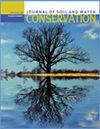Aerial interseeding and planting green to enhance nitrogen capture and cover crop biomass carbon
IF 2.6
4区 农林科学
Q2 ECOLOGY
引用次数: 0
Abstract
The US state of Maryland incentivizes farmers to plant cover crops to reduce nitrogen (N) loading to the Chesapeake Bay and to sequester carbon (C). Maryland has a greater percentage of agricultural land in cover crops than any other state, but Maryland farmers typically plant cover crops in October, after harvest and terminate them early in spring, thus severely limiting the cover crop growing time with sufficient temperatures. We hypothesized that extending the cover crop growing season, by interseeding cover crops earlier in fall and terminating them later in the spring, would increase both fall and spring cover crop biomass and N content, reduce nitrate (NO3) leached during winter through early spring, increase soil mineral N, and increase soil moisture in early summer. We tested this hypothesis across 18 site-years by partnering with commercial farmers on the Eastern Shore of Maryland. The farmers managed a brassica-legume-cereal cover crop on their corn (Zea mays L.) or soybean (Glycine max [L.] Merr.) fields according to three treatments: (1) aerial interseed cover crop prior to cash crop harvest and terminate it at or after cash crop planting (Extended); (2) drill cover crop after cash crop harvest and terminate it several weeks before cash crop planting (Standard); and (3) a no-cover crop control in 2018 and 2019 (No Cover). For each treatment, we measured cover crop biomass + N content (fall and spring), NO3 in 70 or 100 cm deep drainage water (fall-winter), as well as soil mineral N and moisture (in June). The Extended treatment exhibited higher fall biomass (1,700 versus 294 kg ha−1) and total N content (65.3 versus 9.6 kg N ha−1) only in a wet year, but produced greater spring cover crop biomass and N content than the Standard treatment every year. In the year with a very wet fall, NO3-N leaching loss was reduced by 84% for Extended and by 45% for Standard compared to No Cover. We found no difference in NO3 leaching between Extended and Standard in years with a dry fall (2017 and 2019). Averaged over all three years, Extended and Standard did not differ in June soil NO3 concentration. Greater reductions in NO3 leaching may make early aerial interseeding preferable to post-harvest drilling, while increased biomass produced in spring with later termination made Extended desirable for increased C inputs. Hence, extending the cover-cropping season can be beneficial to the farmer and to the environment due to increased fall and spring cover crop C inputs to the soil and reduced NO3 leaching in wet years, reducing potential eutrophication of nearby waterways.空中间种和绿植提高氮素捕获和覆盖作物生物量碳
美国马里兰州鼓励农民种植覆盖作物,以减少向切萨皮克湾(Chesapeake Bay)的氮(N)负荷,并封存碳(C)。马里兰州种植覆盖作物的农业土地比例高于其他任何州,但马里兰州农民通常在收获后的10月种植覆盖作物,并在早春终止,因此严重限制了覆盖作物在足够温度下的生长时间。我们假设延长覆盖作物的生长季节,通过在秋季早期播种覆盖作物,在春季晚些时候终止覆盖作物,可以增加秋季和春季覆盖作物的生物量和氮含量,减少冬季到早春期间的硝态氮(NO3)淋滤,增加土壤矿质氮,增加初夏土壤水分。我们通过与马里兰州东海岸的商业农民合作,在18个地点的时间里检验了这一假设。农民们在他们的玉米(Zea mays L.)或大豆(Glycine max [L.)上种植芸苔-豆类-谷物覆盖作物。(1)在经济作物收获前进行空中间种覆盖,并在经济作物种植时或种植后终止间种覆盖(延期);(2)在经济作物收获后钻盖,在经济作物种植前几周终止(标准);(3) 2018年和2019年的无覆盖作物控制(无覆盖)。对于每个处理,我们测量了覆盖作物生物量+ N含量(秋季和春季),70或100 cm深排水中的NO3含量(秋冬季),以及土壤矿质氮和水分(6月)。扩展处理仅在湿润年份表现出更高的秋季生物量(1,700比294 kg ha - 1)和总氮含量(65.3比9.6 kg N ha - 1),但每年的春季覆盖作物生物量和氮含量都高于标准处理。在秋季非常潮湿的年份,与不覆盖相比,扩展覆盖减少了84%,标准覆盖减少了45%。我们发现,在干旱的秋季(2017年和2019年),扩展版和标准版的NO3浸出量没有差异。从3年平均值来看,“标准”与“标准”6月土壤NO3浓度无显著差异。NO3淋失的减少可能使早期空中间作比收获后的钻孔更可取,而春季生物量的增加和后期终止使得延长对增加的C投入更可取。因此,延长覆盖种植季节对农民和环境都是有益的,因为秋季和春季覆盖作物向土壤中投入的碳增加了,湿润年份的NO3淋失减少了,减少了附近水道的潜在富营养化。
本文章由计算机程序翻译,如有差异,请以英文原文为准。
求助全文
约1分钟内获得全文
求助全文
来源期刊
CiteScore
4.10
自引率
2.60%
发文量
0
审稿时长
3.3 months
期刊介绍:
The Journal of Soil and Water Conservation (JSWC) is a multidisciplinary journal of natural resource conservation research, practice, policy, and perspectives. The journal has two sections: the A Section containing various departments and features, and the Research Section containing peer-reviewed research papers.

 求助内容:
求助内容: 应助结果提醒方式:
应助结果提醒方式:


